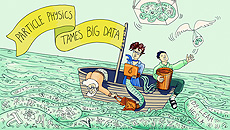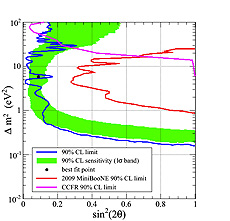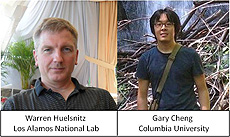|
Have a safe day!
Thursday, Aug. 16
2:30 p.m.
Theoretical Physics Seminar - Curia II
Speaker: Luca Vecchi, Los Alamos National Laboratory
Title: On Partial Compositeness and the CP Asymmetry in Charm Decays
3:30 p.m.
DIRECTOR'S COFFEE BREAK -
2nd Flr X-Over
THERE WILL BE NO ACCELERATOR PHYSICS AND TECHNOLOGY SEMINAR TODAY
Friday, Aug. 17
3:30 p.m.
DIRECTOR'S COFFEE BREAK - 2nd Flr X-Over
4 p.m.
Joint Experimental-Theoretical Physics Seminar (NOTE LOCATION) - Auditorium
Speaker: Tulika Bose, Boston University
Title: Review of LHC Summer 2012 Results (in conjunction with HCP Summer School)
Click here for NALCAL,
a weekly calendar with links to additional information.
Upcoming conferences |
|
Thursday, Aug. 16
- Breakfast: corned-beef hash and one egg
- Harvest moon vegetable soup
- Sloppy joe
- Baja chicken enchilada casserole
- Smart cuisine: ancho chili barbecue beef
- Buffalo chicken tender wrap
- Pizza puffs
- Grilled- or crispy-chicken Caesar salad
Wilson Hall Cafe Menu |
|
Friday, Aug. 17
Dinner
Closed
Wednesday, Aug. 22
Lunch
- Chile rellenos
- Spanish rice
- Confetti salad
- Pineapple flan
Chez Leon Menu
Call x3524 to make your reservation.
|
|
Particle physics tames big data
 |
As science produces an ever-growing flood of information, researchers in many fields struggle with how to collect, store, manage and distribute "big data." Perhaps they could learn a thing or two from particle physics, a field that's been awash in enormous data sets for decades.
|
Nearly everything about high-energy physics research is big—the thousands of scientists on a single experiment, the miles-long accelerators, the stories-high detectors. Yet "big" doesn't begin to describe the torrent of data that gushes out of high-energy physics experiments every day. Out of sheer necessity, particle physicists are virtuosos at plying vast troves of data into meaningful physics.
Consider CERN's Large Hadron Collider. A year of collisions at a single LHC experiment generates close to 1 million petabytes of raw data. If they kept it all, scientists would be looking at enough data to fill roughly 1 billion good-sized hard drives from a computer retailer.
"You can think about walking into a Best Buy with a big checkbook and saying, 'Give me 10,000 disks,'" says Argonne National Laboratory scientist Tom LeCompte, a collaborator at CERN's ATLAS experiment. "It's expensive, but it's not unimaginable." But walking in and saying, "Give me a billion disks"? That, he says, would be inconceivable.
Filtering and managing large data sets is of course not exclusive to particle physics. Researchers in all fields of science, government and industry are mapping ever-increasing amounts of information in ever-greater detail. The trend is known as big data.
The work of the experimental science community is to bring those volumes of complex data within the scale of the imaginable.
It's a goal particle physicists have been working on for decades.
Read more
—Leah Hesla
|
Microsoft home use and e-learning
Did you know that as part of Fermilab's enterprise agreement with Microsoft, all Fermilab employees can purchase certain Microsoft software at greatly discounted rates and receive free online training?
The Microsoft Home Use program entitles employees to purchase one copy of selected products that they have licensed on their work computer for use on their home computers at $9.95 each. The following software is available: Office Professional Plus 2010, Office for Mac 2011, Microsoft Project Professional 2010 and Microsoft Visio Premium 2010. For more information and for instructions on how to order, see Common Questions about the Microsoft Home Use Program.
Microsoft also offers Fermilab employees the chance to sharpen their skills by taking free e-learning courses. For a list of sample of courses offered and instruction on how to enroll, see Microsoft E-Learning Sample Classes and Enrollment.
|
Quark Matter's connection with the Higgs
From Brookhaven Today, Aug. 13, 2012
You may think you've heard everything you need to know about the origin of mass. After all, scientists colliding protons at the Large Hadron Collider (LHC) in Europe recently presented stunning evidence strongly suggesting the existence of a long-sought particle called the Higgs boson, thought to "impart mass to matter." But while the Higgs particle may be responsible for the mass of fundamental particles such as quarks, quarks alone can't account for the mass of most of the visible matter in the universe—that's everything we see and sense around us.
To get a grasp on what holds these visible forms of matter together—everything from stars to planets to people—you have to understand how quarks and gluons interact. That's the essence of quark matter physics—and the Quark Matter 2012 international conference, taking place in Washington, D.C., August 12-18.
Read more
|
Viewpoint: a fuller picture of the Higgs boson
From Physics, Aug. 14, 2012
In the history of particle physics, 2012 will be remembered as a milestone. On July 4th, 2012, two experimental groups, ATLAS and CMS, which run independent detectors at the Large Hadron Collider (LHC), announced that after a year of dedicated searches for the Higgs boson, they had discovered a new particle with a mass of 125 giga-electron-volts (GeV). At this stage, we cannot yet be sure if this particle is really a Higgs boson, and additional studies and experimental verification will be needed to pin the new particle down. For now, the next set of experimental tests will be devoted to determining if this Higgs-boson-like particle behaves as predicted—or, what might be more interesting, finding out that it doesn't. Now, complementing the discovery reports from the LHC, two experimental collaborations, CDF and D0, from the Tevatron at Fermilab, are reporting in Physical Review Letters the results of their Higgs search, which shows evidence that a particle, with a mass similar to the new particle discovered at the LHC, decays into quarks. Such decays are expected to exist if the same mechanism underlies the masses of fermions as underlies the particles that mediate force (gauge bosons), but the new paper is the first experimental evidence that the decays are possible.
Read more
|
|
The search for new physics in Fermilab's Booster neutrino beamline
 |
| In this joint MiniBooNE-SciBooNE analysis, the experiments have excluded the area to the right of the 90 percent confidence level limit curve (blue) as a region where muon antineutrino disappearance may be occurring. This significantly narrows down the oscillation region for sterile neutrinos. |
The conventional picture of neutrinos involves three types: the electron neutrino (and antineutrino), the muon (anti)neutrino, and the tau (anti)neutrino. As they zip through matter or space, the three types, or flavors, continually morph into each other in a phenomenon called neutrino oscillation. On the rare occasions that they interact with matter, they do so through the weak nuclear force.
But there is growing evidence for short-baseline neutrino anomalies that cannot be explained by the conventional picture. These anomalies include both an excess of events observed by Los Alamos National Laboratory's Liquid Scintillator Neutrino Detector experiment and Fermilab's MiniBooNE experiment and a deficit of events observed by reactor and radioactive-source experiments. If these anomalies are in fact due to neutrinos changing from one flavor to another, then there must be one or more new kinds of neutrinos. These additional neutrinos may be what are called "sterile neutrinos" because they do not interact by the weak nuclear force.
The MiniBooNE experiment, operating in Fermilab's Booster neutrino beamline since 2002, can search for the appearance of electron (anti)neutrinos or the disappearance of muon (anti)neutrinos. MiniBooNE has reported on appearance signals consistent with the Los Alamos LSND experiment. If electron (anti)neutrino appearance in the Booster neutrino beamline is due to oscillations, with a sterile neutrino acting as an intermediary between electron flavor and muon flavor (anti)neutrinos, then observation of the muon (anti)neutrino disappearance would be a smoking-gun signal for the presence of these sterile neutrinos. With some back-of-the-envelope calculations, it can be shown that on the order of 10 percent of the muon (anti)neutrinos, at certain energies, should be transitioning to sterile neutrinos and hence be unobservable.
MiniBooNE performed a search for muon neutrino or antineutrino disappearance in 2009 and found no evidence for disappearance. However, the antineutrino analysis in particular was severely limited by systematic and statistical uncertainties. The experiment repeated the search for muon neutrino disappearance last year, with the inclusion of data from the SciBooNE detector. While MiniBooNE operated at a distance of 540 meters from the neutrino production target, SciBooNE was at a distance of 100 meters and helped to reduce some of the uncertainties in the number of neutrinos in the beam and the likelihood for neutrinos to interact in the detector. Once again, the results were consistent with no disappearance.
We have just completed an improved search for muon antineutrino disappearance using data from both the MiniBooNE and SciBooNE detectors. By bootstrapping off other muon neutrino measurements in MiniBooNE and SciBooNE, as well as by using a larger antineutrino data set and including improvements in the analysis methodology, the collaborations were able to significantly improve sensitivity for muon antineutrino disappearance. The results obtained are consistent with no short-baseline disappearance, and they have dramatically improved the excluded regions of the parameter space for short-baseline neutrino oscillations, pushing into the region of interest for sterile neutrino models. At Δm2 =1 eV2, the 90 percent confidence level limit is at sin2(2θ) = 0.12.
—Warren Huelsnitz
 |
| These physicists are responsible for this analysis.
|
|
Retirement party for Jeff Appel - today
The directorate is hosting a retirement party for Jeff Appel today at 3:30 p.m. on the 2nd-floor crossover in Wilson Hall. He retired in July after nearly 37 years of service to the laboratory. Stop by to wish him well.
|
|